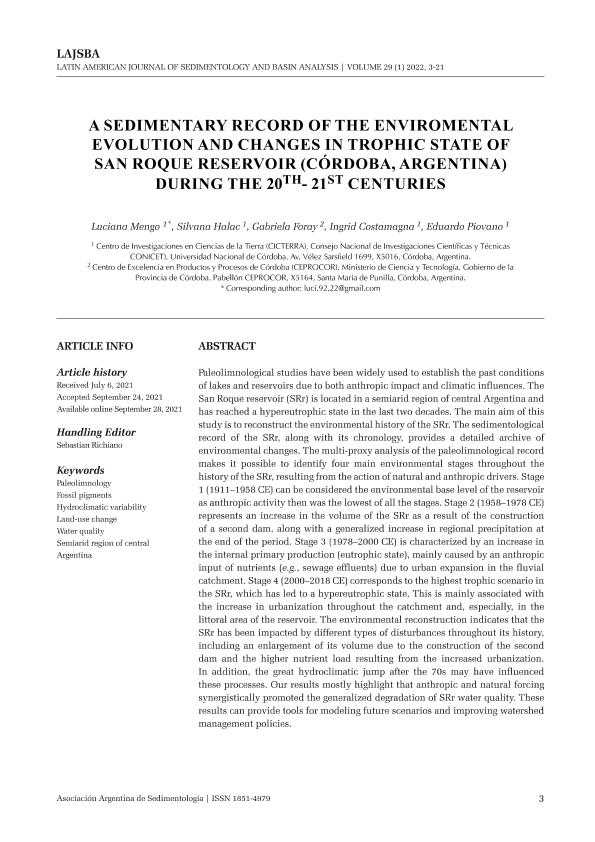Mostrar el registro sencillo del ítem
dc.contributor.author
Mengo, Luciana del Valle

dc.contributor.author
Halac, Silvana Raquel

dc.contributor.author
Foray, Silvia Gabriela

dc.contributor.author
Costamagna, Ingrid

dc.contributor.author
Piovano, Eduardo Luis

dc.date.available
2023-10-30T13:30:36Z
dc.date.issued
2022-01
dc.identifier.citation
Mengo, Luciana del Valle; Halac, Silvana Raquel; Foray, Silvia Gabriela; Costamagna, Ingrid; Piovano, Eduardo Luis; A sedimentary record of the environmental evolution and changes in trophic state of San Roque reservoir (Córdoba, Argentina) during the 20th–21st centuries; Asociación Argentina de Sedimentología; Latin American Journal of Sedimentology and Basin Analysis; 29; 1; 1-2022; 3-21
dc.identifier.issn
1669-7316
dc.identifier.uri
http://hdl.handle.net/11336/216361
dc.description.abstract
Paleolimnological studies have been widely used to establish the past conditions of lakes and reservoirs due to both anthropic impact and climatic influences. The San Roque reservoir (SRr) is located in a semiarid region of central Argentina and has reached a hypereutrophic state in the last two decades. The main aim of this study is to reconstruct the environmental history of the SRr. The sedimentological record of the SRr, along with its chronology, provides a detailed archive of environmental changes. The multi-proxy analysis of the paleolimnological record makes it possible to identify four main environmental stages throughout the history of the SRr, resulting from the action of natural and anthropic drivers. Stage 1 (1911–1958 CE) can be considered the environmental base level of the reservoir as anthropic activity then was the lowest of all the stages. Stage 2 (1958–1978 CE) represents an increase in the volume of the SRr as a result of the construction of a second dam, along with a generalized increase in regional precipitation at the end of the period. Stage 3 (1978–2000 CE) is characterized by an increase in the internal primary production (eutrophic state), mainly caused by an anthropic input of nutrients (e.g., sewage effluents) due to urban expansion in the fluvial catchment. Stage 4 (2000–2018 CE) corresponds to the highest trophic scenario in the SRr, which has led to a hypereutrophic state. This is mainly associated with the increase in urbanization throughout the catchment and, especially, in the littoral area of the reservoir. The environmental reconstruction indicates that the SRr has been impacted by different types of disturbances throughout its history, including an enlargement of its volume due to the construction of the second dam and the higher nutrient load resulting from the increased urbanization. In addition, the great hydroclimatic jump after the 70s may have influenced these processes. Our results mostly highlight that anthropic and natural forcing synergistically promoted the generalized degradation of SRr water quality. These results can provide tools for modeling future scenarios and improving watershed management policies.
dc.format
application/pdf
dc.language.iso
eng
dc.publisher
Asociación Argentina de Sedimentología
dc.rights
info:eu-repo/semantics/openAccess
dc.rights.uri
https://creativecommons.org/licenses/by-nc/2.5/ar/
dc.subject
PALEOLIMNOLOGY
dc.subject
FOSSIL PIGMENTS
dc.subject
HYDROCLIMATE VARIABILITY
dc.subject
LAND USE CHANGE
dc.subject.classification
Otras Ciencias de la Tierra y relacionadas con el Medio Ambiente

dc.subject.classification
Ciencias de la Tierra y relacionadas con el Medio Ambiente

dc.subject.classification
CIENCIAS NATURALES Y EXACTAS

dc.title
A sedimentary record of the environmental evolution and changes in trophic state of San Roque reservoir (Córdoba, Argentina) during the 20th–21st centuries
dc.type
info:eu-repo/semantics/article
dc.type
info:ar-repo/semantics/artículo
dc.type
info:eu-repo/semantics/publishedVersion
dc.date.updated
2023-10-26T15:19:38Z
dc.identifier.eissn
1851-4979
dc.journal.volume
29
dc.journal.number
1
dc.journal.pagination
3-21
dc.journal.pais
Argentina

dc.journal.ciudad
La Plata
dc.description.fil
Fil: Mengo, Luciana del Valle. Consejo Nacional de Investigaciones Científicas y Técnicas. Centro Científico Tecnológico Conicet - Córdoba. Centro de Investigaciones en Ciencias de la Tierra. Universidad Nacional de Córdoba. Facultad de Ciencias Exactas Físicas y Naturales. Centro de Investigaciones en Ciencias de la Tierra; Argentina
dc.description.fil
Fil: Halac, Silvana Raquel. Consejo Nacional de Investigaciones Científicas y Técnicas. Centro Científico Tecnológico Conicet - Córdoba. Centro de Investigaciones en Ciencias de la Tierra. Universidad Nacional de Córdoba. Facultad de Ciencias Exactas Físicas y Naturales. Centro de Investigaciones en Ciencias de la Tierra; Argentina
dc.description.fil
Fil: Foray, Silvia Gabriela. Provincia de Córdoba. Ministerio de Ciencia y Técnica. Centro de Excelencia en Productos y Procesos de Córdoba; Argentina
dc.description.fil
Fil: Costamagna, Ingrid. Consejo Nacional de Investigaciones Científicas y Técnicas. Centro Científico Tecnológico Conicet - Córdoba. Centro de Investigaciones en Ciencias de la Tierra. Universidad Nacional de Córdoba. Facultad de Ciencias Exactas Físicas y Naturales. Centro de Investigaciones en Ciencias de la Tierra; Argentina
dc.description.fil
Fil: Piovano, Eduardo Luis. Consejo Nacional de Investigaciones Científicas y Técnicas. Centro Científico Tecnológico Conicet - Córdoba. Centro de Investigaciones en Ciencias de la Tierra. Universidad Nacional de Córdoba. Facultad de Ciencias Exactas Físicas y Naturales. Centro de Investigaciones en Ciencias de la Tierra; Argentina
dc.journal.title
Latin American Journal of Sedimentology and Basin Analysis
dc.relation.alternativeid
info:eu-repo/semantics/altIdentifier/url/https://lajsba.sedimentologia.org.ar/index.php/lajsba/article/view/29-1-2
Archivos asociados
